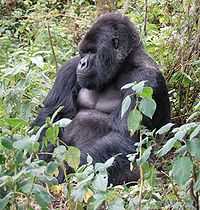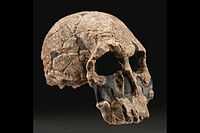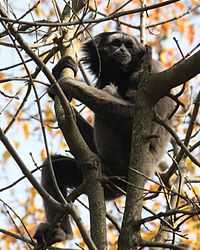Anthropology/Lecture
< Anthropology
"Some 540,000 years ago, an ancient ancestor of modern humans took a shark tooth and carefully carved a geometric engraving [shown close-up in the image on the right] on a mollusk shell."[1]
"The engraving -- the oldest piece of art ever found by at least 300,000 years -- as well as a shell tool were found at a site in what is now Java, Indonesia."[1]
Behaviors
"The work [at the top right of this lecture] strongly suggests that Homo erectus, aka "Upright Man," was far more sophisticated than previously thought, being capable of cognition and behavior only attributed before to our species."[1]
"It was probably through the opening of shells with a shark tooth for food that at least one individual made a 'next step' by putting the tool to the shell for scratching lines, instead of, or in addition to, drilling a hole for opening the shell."[2]
Pre-history
"The age of the engraving is astounding, as no other art, even cave and rock paintings, are as old."[1]
Archaeology
The discovery was made while "studying a fossil freshwater mussel shell assemblage from a site called Trinil in Java. The mussel shells originally were excavated by Eugène Dubois in the 1890s, but have been stored in the Dubois collection of the Naturalis museum in Leiden, The Netherlands. Sediment within the shells enabled them to be dated using both isotopic and luminescence methods."[1]
Artistry
"When we tried to reproduce such a pattern by engraving a fresh shell with a shark tooth, we found it required a lot of strength and skill, especially to make such neat angles where the lines are exactly joined together," Joordens said. "The maker certainly must have put a lot of effort in it. Also, it is important to appreciate that originally the lines must have been white on a black-brown background: visually very striking."[2]
Humanities
"The good thing about these aquatic resources (shellfish) is that they are abundantly present and easy to collect, and very nutritious, so this would imply that life was not too tough for Homo erectus there."[2]
"They no doubt spent much of their time on land gathering food, and we know they butchered large mammals, but their very heavy bones suggest they never moved far from water, and apparently regularly foraged in the water."[3]
Theoretical anthropology
Def. "[t]he holistic scientific and social study of humanity, mainly using ethnography as its method"[4] is called anthropology.
"Anthropology is distinguished from other social science disciplines by its emphasis on in-depth examination of context, cross-cultural comparisons, and the importance it places on long-term, experiential immersion in the area of research."[4]
Biological anthropology


Some thirty-two vervet monkey infants in Amboseli National Park, Kenya, are observed from August 1983 to June 1985.[5]
An external factor making it costly for an animal to maintain access to a food item is threats by a high-ranking group member.[5]
"Interactions with dominant group members may thus provide infants with the raw material for recognizing variation in food quality."[5]
"A final possibility is that infants' fear of dominants overrides the importance of food quality."[5] Dominants "may instill a general level of fear in infants, regardless of food types, and thus abandon distance in infants is not expected to vary by food category."[5]
The "whole genome of the mountain gorilla (Gorilla beringei beringei) [has been sequenced] and compared [...] with the genomes of three other Gorilla subspecies – the western lowland gorilla (G. gorilla gorilla), the Cross River gorilla (G. g. diehli), and the eastern lowland gorilla (G. b. graueri)."[6]
"They are known from two separate locations: the Virunga range of extinct volcanic mountains on the borders of the Democratic Republic of Congo, Rwanda and Uganda, and in the Bwindi Impenetrable National Park in Uganda. Some scientists believe the Bwindi gorillas may be a separate subspecies."[6]
“Mountain gorillas are among the most intensively studied primates in the wild, but this is the first in-depth, whole-genome analysis.”[6]
“Three years on from sequencing the gorilla reference genome, we can now compare the genomes of all gorilla populations, including the critically endangered mountain gorilla, and begin to understand their similarities and differences, and the genetic impact of inbreeding.”[6]
"[T]hese mountain gorillas, along with eastern lowland gorillas, were two to three times less genetically diverse than gorillas from larger groups in western regions of central Africa."[6]
"Fewer harmful loss-of-function variants were found in the mountain gorilla population than in the more numerous western gorilla populations."[6]
"[M]ountain gorillas have survived in small numbers for thousands of years."[6]
Cultural anthropology
Most nativistic movements "have as a common denominator a situation of inequality [that] ... may derive either from the attitudes of the societies involved or from actual situations of dominance and submission."[7]
In the Southwest, the Anglo-Americans dominate Indians and Mexicans alike.[7]
"[T]he technological superiority of European culture has, until recently, rendered the dominance of colonial groups secure."[7]
"Nativistic movements tend to arise only when the members of the subject society find that their assumption of the culture of the dominant group is being effectively opposed by it, or that it is not improving their social position."[7]
Analysis: three apparent dominant groups are identified:
- whites,[7]
- Anglo-Americans,[7] and
- colonial groups.[7]
Dominant group is used to refer to the group of whites, Anglo-Americans, and colonial groups, each of which is in turn a dominant group.[7] These dominant subgroups are identified as indicated by respective links. "Colonial groups" refers to several groups of immigrants to America. North America has been divided into European immigrant territories based on control such as British America, French America, Spanish America, Russian America, Dutch America, and Norse America.
The relation to one another is that they are dominant groups of individuals, or peoples, originating in Europe. The population is North Americans in the location of North America.
Dominance appears to result from
These may have been replaced to some extent by distinctive powers and privileges, since the culture pattern of the dominant group of European-ancestor North Americans now preclude the use of forcible methods.[7]
"Having established that cultural/language differences between the dominant group and the schools, on the one hand, and the minorities, on the other, existed, and that the difficulties in social adjustment and academic performance experienced by minority children might be due to such cultural/language differences, anthropological research developed into a second stage. ... [S]ome minority groups do well in school even though they do not share the language and cultural backgrounds of the dominant group that are reflected in school features and practices."[8]
"The difference, as writers like Talal Asad within anthropology and Norman Fairclough within linguistics (Language and Power, 1989) would argue, is that the notion of hegemony problematises how a common social-moral language-a given discourse- achieves and reproduces its dominance, whereas earlier accounts of culture appeared to accept at face value the representations of the dominant group and their claim to speak for all."[9]
Ethnography
Def. "[t]he common characteristics of a group of people"[10] is called ethnicity.
Def. the science and scientific descriptions of "specific human cultures and societies"[11] is called ethnography.
"Ethnography (from Greek ἔθνος ethnos = folk/people and γράφω grapho = to write) is a qualitative research design aimed at exploring cultural phenomena. The resulting field study or a case report reflects the knowledge and the system of meanings in the lives of a cultural group.[12][13][14] An ethnography is a means to represent graphically and in writing, the culture of a people."[15]
Def. "[t]he branch of anthropology that studies and compares the different human cultures"[16] is called ethnology.
"Ethnology (from the Greek ἔθνος, ethnos meaning "people, nation, race") is the branch of anthropology that compares and analyzes the origins, distribution, technology, religion, language, and social structure of the ethnic, racial, and/or national divisions of humanity.[17]"[18]
"Compared to ethnography, the study of single groups through direct contact with the culture, ethnology takes the research that ethnographers have compiled and then compares and contrasts different cultures."[18]
"Anthropology is not just ethnography; in fact, the meanings which can be attached to ethnographic case studies depend on wider schemes, on classifications of societies, and on polemics which generate interest in particular projects at particular times."[19]
"I. M. Lewis has argued that spirit possession frequently provides a means for oppressed or deprived groups such as women to exert pressure upon or attack the dominant group (Lewis 1986: 23-50).4 Once a claim of this kind has been made, either on the basis of ethnographic descriptions or theoretical expectations, further ethnographic material cannot be introduced in a neutral way."[19]
"So, an ethnographer who enters the scene on the presumption that the social arrangements in a particular school or classroom will favor the interests of a dominant group is undeniably looking for hegemonic practices."[20]
"The problem becomes more complex when it is realized that in Kanuri-dominated towns such people often accept the dominant group's term and claim they are Kirdi."[21]
"While the human groups are many and diverse, they are conveniently combined in two categories: first, the natural or consanguineal or kinship group in which the unit is the ethnos; and second, the artificial or essentially social group in which the unit is the demos. The ethnos, or ethnic group, is the homologue of the varietal or specific group of animals; it is the dominant group in lower savagery, but its influence on human life wanes upward, to practically disappear in enlightenment except as retained in the structure of the family. The demos is the product of intelligence applied to the regulation of human affairs; it has no true homologue among animals; its importance waxes as that of the ethnos wanes from savagery through barbarism and civilization and thence into enlightenment."[22]
Linguistic anthropology
"In the case of Aboriginal Australia, differences between economic and political systems, at least using the categories usually quoted in relation to language replacement, are largely absent. Australian Aboriginal societies are classless and stateless, and it seems highly unlikely that any form of centralised organisation and elite hierarchy existed in the past."[23]
"Pidginisation occurs where there is a close economic relationship between two peoples; the pidgin is derived from the language of the dominant partner in the relationship. Such a relationship and the dominance of one side could be inferred from archaeological evidence, independently."[23]
"Such a relationship may just as well result in the adoption of the dominant group's language as a lingua franca without significant pidginisation."[23]
"Other aspects which have been suggested as crucial for pidgin simplification to occur are: (a) an attitude on the part of the dominant language speakers that their language cannot or should not be learnt by foreigners except in a simplified /'debased1 form; (b) a degree of actual complexity/difficulty in the dominant language."[23]
Analysis: members of the dominant group are in the relationship of being "dominant partner"s.
The population is "Aboriginal societies" in the location of Australia.
Investigating the source of dominance includes
"While no relic language or group can be identified amid the southern Pama-Nyungan block of languages, the Yolngu languages of north-eastern Arnhem Land clearly constitute a northern offshoot of Pama-Nyungan entirely surrounded by non-Parna-Nyungan languages."[23],
"[T]he fact that in this myth this change in technology also accompanies a change from female to male control of circumcision ritual might encourage us to give consideration to ideas that radical change in ritual and social organisation has occurred and its traces can be detected."[23], and
"These are areas where Macassan influence was also strong."[23]
Dominance may refer to "surrounded", "strong influence", or new technology and an accompanying "prehistoric change from matrimoieties to patrimoieties"[23].
Paleanthropology


Def. the "scientific study of fossil humans, and the evolution of modern man"[24] is called paleanthropology.
"There is only one really good fossil of this Homo rudolfensis: KNM-ER 1470, from Koobi Fora in the Lake Turkana basin, Kenya. It has one really critical feature: a braincase size of 775 cubic centimeters, which is considerably above the upper end of H. habilis braincase size. At least one other braincase from the same region also shows such a large cranial capacity."[25]
Def. an "ape of the family Hominidae, having a mostly hairless face, hands with complex fingerprints, and flat fingernails. Includes chimpanzees and gorillas (subfamily Homininae), and orangutans (subfamily Ponginae). Usage may vary to either include or exclude humans (members of Homininae subfamily)"[26] is called a great ape.
Def. any "great ape (including humans and apes) belonging to the superfamily Hominoidea"[27] is called a hominoid.
Physical anthropology
"The Aztecs who conquered the city of Xaltocan in ancient Mexico around 1435 may have fundamentally changed the genetic makeup of the people who lived there ... maternal DNA from 25 residents of Xaltocan prior to the conquest did not match that found after. ... Xaltocan was the capital of a pre-Aztec city-state ruled by the Otomi, an indigenous people who lived in Mexico. ... Colonial records from the 1500s onward told tales of the Otomi fleeing the city en masse in 1395. "It's likely that some people did leave, probably the elites who no longer had the same social roles," Overholzer said. "It's also possible that when some people left, more valuable land was made newly available and so people moved around within the site.""[28] Ruling elites is a relative synonym for dominant group.
Social anthropology
"For ethnic groups, [Niominkas and Serer people,] Wolofs and Lebus, Tukulors and Fulas, Bambaras and Soninkes, Diolas and Manjaks were respectively grouped together since the social structure and historical background of each member of the pair were closely related."[29]
Ethnicity is a central concept in social anthropology and traditionally considered as prominent in determinism of behavior.[30]
"In Senegal, Wolofs and Lebus represent the dominant group (43 per cent of total population) as well as the oldest one in the Dakar area."[29]
Research
Hypothesis:
- Hominoids with larger brain sizes than a chimpanzee may have been driven to extinction by Homo sapiens.
Control groups

The findings demonstrate a statistically systematic change from the status quo or the control group.
“In the design of experiments, treatments [or special properties or characteristics] are applied to [or observed in] experimental units in the treatment group(s).[31] In comparative experiments, members of the complementary group, the control group, receive either no treatment or a standard treatment.[32]"[33]
Proof of concept
Def. a “short and/or incomplete realization of a certain method or idea to demonstrate its feasibility"[34] is called a proof of concept.
Def. evidence that demonstrates that a concept is possible is called proof of concept.
The proof-of-concept structure consists of
- background,
- procedures,
- findings, and
- interpretation.[35]
See also
References
- 1 2 3 4 5 Jennifer Viegas (3 December 2014). "Oldest Art Was Carved Onto Shell 540,000 Years Ago". Discovery.com. Retrieved 2014-12-07.
- 1 2 3 Josephine Joordens (3 December 2014). "Oldest Art Was Carved Onto Shell 540,000 Years Ago". Discovery.com. Retrieved 2014-12-07.
- ↑ Stephen Munro (3 December 2014). "Oldest Art Was Carved Onto Shell 540,000 Years Ago". Discovery.com. Retrieved 2014-12-07.
- 1 2 "anthropology, In: Wiktionary". San Francisco, California: Wikimedia Foundation, Inc. 27 January 2013. Retrieved 2013-01-27.
- 1 2 3 4 5 Marc D. Hauser (September 1993). "Ontogeny of foraging behavior in wild vervet monkeys (Cercopithecus aethiops): Social interactions and survival". Journal of Comparative Psychology 107 (3): 276-82. doi:10.1037/0735-7036.107.3.276. http://www.wjh.harvard.edu/~mnkylab/publications/animalcommunication/ontogforag.pdf. Retrieved 2011-08-29.
- 1 2 3 4 5 6 7 Chris Tyler-Smith and Dr Aylwyn Scally (9 April 2015). "Mountain Gorillas Reveal Their Genetic Secrets". Sci-News. Retrieved 2015-06-21.
- 1 2 3 4 5 6 7 8 9 10 11 Ralph Linton (April-June 1943). "Nativistic movements". American Anthropologist 45 (2): 230-40. doi:10.1525/aa.1943.45.2.02a00070. http://onlinelibrary.wiley.com/doi/10.1525/aa.1943.45.2.02a00070/full. Retrieved 2011-07-26.
- ↑ John U. Ogbu (December 1987). "Variability in Minority School Performance: A Problem in Search of an Explanation". Anthropology & Education Quarterly 18 (4): 312-34. doi:10.1525/aeq.1987.18.4.04x0022v. http://onlinelibrary.wiley.com/doi/10.1525/aeq.1987.18.4.04x0022v/abstract. Retrieved 2012-05-12.
- ↑ Brian V. Street (1993). David Graddol, Linda Thompson, Michael Byram. ed. Culture is a Verb: Anthropological aspects of language and cultural process, In: Language and Culture. Clevedon, United Kingdom: Multilingual Matters Ltd. pp. 23-43. ISBN 1-85359-207-2. http://books.google.com/books?hl=en&lr=&id=U2NTxpfrapkC&oi=fnd&pg=PA23&ots=mw2ji1CTOB&sig=4X_Woz32aHIHIXI0GNgXZS8Umds. Retrieved 2012-05-12.
- ↑ "ethnicity, In: Wiktionary". San Francisco, California: Wikimedia Foundation, Inc. December 14, 2012. Retrieved 2013-01-27.
- ↑ "ethnography, In: Wiktionary". San Francisco, California: Wikimedia Foundation, Inc. October 17, 2012. Retrieved 2013-01-27.
- ↑ Geertz, C. (1973). Thick description: Toward an interpretive theory of culture.
- ↑ In The Interpretation of Cultures: Selected Essays (pp 3-30). New York: Basic Books, Inc., Publishers
- ↑ Philipsen, G. (1992). Speaking Culturally: Explorations in Social Communication. Albany, New York: State University of New York Press
- ↑ "Ethnography, In: Wikipedia". San Francisco, California: Wikimedia Foundation, Inc. January 24, 2013. Retrieved 2013-01-27.
- ↑ "ethnology, In: Wiktionary". San Francisco, California: Wikimedia Foundation, Inc. November 3, 2012. Retrieved 2013-01-27.
- ↑ Newman, Garfield, et al. (2008). Echoes from the past: world history to the 16th century. Toronto: McGraw-Hill Ryerson Ltd. ISBN 0-07-088739-X.
- 1 2 "Ethnology, In: Wikipedia". San Francisco, California: Wikimedia Foundation, Inc. January 25, 2013. Retrieved 2013-01-27.
- 1 2 Nicholas Thomas (July 15, 1996). Out of Time: History and Evolution in Anthropological Discourse Second Edition. Ann Arbor, Michigan: University of Michigan Press. pp. 176. ISBN 0-472-08377-5. http://books.google.com/books?hl=en&lr=&id=dSdX8FshfzYC&oi=fnd&pg=PP13&ots=K2txLHIiu1&sig=pcjN8TTrVNWnhShEraLlvKPSe6s. Retrieved 2012-02-17.
- ↑ L Brodkey (June 1987). "Writing critical ethnographic narratives". Anthropology & Education Quarterly 18 (2): 67-76. doi:10.1525/aeq.1987.18.2.04x0666p. http://onlinelibrary.wiley.com/doi/10.1525/aeq.1987.18.2.04x0666p/abstract. Retrieved 2012-02-17.
- ↑ Ronald Cohen (1978). "Ethnicity: Problem and Focus in Anthropology". Annual Review of Anthropology 7: 379-403. http://www.jstor.org/stable/10.2307/2155699. Retrieved 2012-02-17.
- ↑ W J McGee (July 1899). "The Trend of Human Progress". American Anthropologist New Series 1 (3): 401-47. http://www.jstor.org/stable/658811?&Search=yes&searchText=%22dominant+group%22&list=hide&searchUri=%2Faction%2FdoAdvancedSearch%3Fq0%3D%2522dominant%2Bgroup%2522%26f0%3Dall%26c1%3DAND%26q1%3D%26f1%3Dall%26wc%3Don%26Search%3DSearch%26sd%3D1890%26ed%3D1900%26la%3D%26jo%3D&prevSearch=&item=3&ttl=3&returnArticleService=showFullText. Retrieved 2011-09-20.
- 1 2 3 4 5 6 7 8 Patrick McConvell (1990). "The linguistic prehistory of Australia: Opportunity for dialogue with archaeology". Australian Archaeology (31): 3-27. http://www.library.uq.edu.au/ojs/index.php/aa/article/viewFile/1330/1324. Retrieved 2011-08-27.
- ↑ Romanophile (6 May 2011). "paleanthropology, In: Wiktionary". San Francisco, California: Wikimedia Foundation, Inc. Retrieved 2015-06-07.
- ↑ V.P. Alexeev (26 May 2015). "Homo rudolfensis". Washington, DC USA: Smithsonian Institution. Retrieved 2015-05-31.
- ↑ "great ape, In: Wiktionary". San Francisco, California: Wikimedia Foundation, Inc. 16 December 2014. Retrieved 2015-06-07.
- ↑ "hominoid, In: Wiktionary". San Francisco, California: Wikimedia Foundation, Inc. 17 October 2014. Retrieved 2015-06-07.
- ↑ Tia Ghose (January 31, 2013). "Aztec Conquerors Reshaped Genetic Landscape of Mexico". Yahoo! News. Retrieved 2013-01-31.
- 1 2 Didier Fassin and Emile Jeannee (April 1989). "Immunization Coverage and Social Differentiation in Urban Senegal". American Journal of Public Health 79 (4): 509-11. PMID 2929817. http://ajph.aphapublications.org/cgi/reprint/79/4/509.pdf. Retrieved 2011-08-29.
- ↑ R. Benedict (1980). Patterns of Culture. London: Routledge and Kegan Paul.
- ↑ Klaus Hinkelmann, Oscar Kempthorne (2008). Design and Analysis of Experiments, Volume I: Introduction to Experimental Design (2nd ed.). Wiley. ISBN 978-0-471-72756-9. http://books.google.com/?id=T3wWj2kVYZgC&printsec=frontcover.
- ↑ R. A. Bailey (2008). Design of comparative experiments. Cambridge University Press. ISBN 978-0-521-68357-9. http://www.cambridge.org/uk/catalogue/catalogue.asp?isbn=9780521683579.
- ↑ "Treatment and control groups, In: Wikipedia". San Francisco, California: Wikimedia Foundation, Inc. May 18, 2012. Retrieved 2012-05-31.
- ↑ "proof of concept, In: Wiktionary". San Francisco, California: Wikimedia Foundation, Inc. November 10, 2012. Retrieved 2013-01-13.
- ↑ Ginger Lehrman and Ian B Hogue, Sarah Palmer, Cheryl Jennings, Celsa A Spina, Ann Wiegand, Alan L Landay, Robert W Coombs, Douglas D Richman, John W Mellors, John M Coffin, Ronald J Bosch, David M Margolis (August 13, 2005). "Depletion of latent HIV-1 infection in vivo: a proof-of-concept study". Lancet 366 (9485): 549-55. doi:10.1016/S0140-6736(05)67098-5. http://www.ncbi.nlm.nih.gov/pmc/articles/PMC1894952/. Retrieved 2012-05-09.
External links
| |||||||||||||||||||||||||||||||||||||||||||||||||||||
| |||||||||||||||||||||||||||||||||||||||||||||||||||||
![]() This is a research project at http://en.wikiversity.org
This is a research project at http://en.wikiversity.org
| |
Educational level: this is a research resource. |
| |
Resource type: this resource is an article. |
| |
Resource type: this resource contains a lecture or lecture notes. |
| |
Subject classification: this is a humanities resource. |